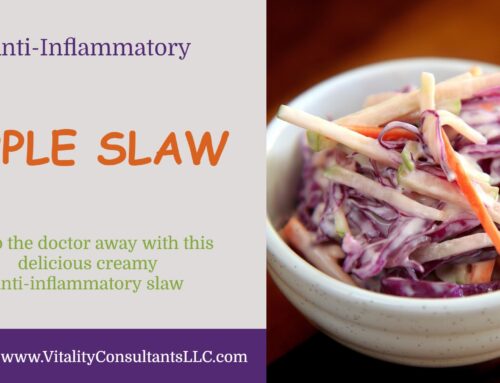
When I was growing up, I would only eat cauliflower if it was smothered in Campbell’s Cheddar Cheese soup. As I continue to hear and read more, I am learning that this beautiful vegetable can actually taste delicious all on its own, without requiring cheese topping! In addition, cauliflower is really good for you…it’s a cruciferous vegetable, like its cousins kale and broccoli. It’s packed with fiber – over 9 grams in every 100 calories – so it’s helpful for your digestive system. And not to get too technical, but research investigating inflammation related health issues have found that vitamin K, and glucosinolates / isothiocyanates in cruciferous vegetables, could provide benefits by reducing inflammation in the body.
Cauliflower is also very versatile, and you can eat it raw (the little florette makes it perfect for dipping – okay I still like it with a little cheese now and then!) or it can be made into hummus, pizza crust, soup or roasted/sauted by itself – there are so many opportunities for fitting cauliflower into your diet. Check out our pinterest page for recipes using cauliflower! Its fairly neutral taste makes it a great option for mixing with different spices to completely change its taste. For example, you can actually turn cauliflower into an anti-inflammatory approved “rice” and depending on the seasonings you choose, you can add an Asian seasoning mix to make it taste like it is coming from your favorite Chinese restaurant, or you can add cinnamon or stevia for a sweeter option. Whatever way you like cauliflower, it’s certainly not your garden variety “flower”.
 How to make “rice” from cauliflower:
How to make “rice” from cauliflower:
- De-stem a head of cauliflower and cut into florettes
- Place 6–7 florettes into a food processor and pulse until reaching a rice-like consistency. Remove the “rice” and repeat with remaining florettes.
- Place a medium stockpot on the stove and fill with 4 cups of chicken broth. Bring broth to a boil. (If you are planning on adding stevia or sweeter spices, use water instead of chicken broth)
- Add “rice” and cook for 1 minute. Drain “rice” and season to taste.
A few tips for this versatile vegetable:
- Avoid spotted and “dull” cauliflower
- Don’t overcook your vegetable, as it will be mushy and not as tasty
- We are still in cauliflower peak season – best from December through March!
Check out our recipe below and some of our anti-inflammatory recipes made with cauliflower on our Pinterest boards:
- Cauliflower Couscous with Shrimp
- Burrito Bowl
- Cauliflower Hummus
- Simple Spanish Rice
- Buffalo Chicken Soup

Roasted Cauliflower Salad
Ingredients
- 2 lb head cauliflower quartered, cored and sliced 1/4" thick
- 5 Tbsp olive oil divided
- 1 tsp coriander seeds smashed
- Salt and pepper to taste
- 2 Tbsp apple cider vinegar
- 1 tsp Dijon mustard
- 2 green onions finely chopped
- ¼ cup golden raisins chopped
- ¼ cup dried cranberries
- ½ cup unsalted roasted almonds chopped
- 2 cups baby arugula
- 1 cup flat-leaf parsley
- Crumbled goat cheese for serving (optional)
Instructions
- Preheat oven to 425°F and place rack in the lower third of the oven.
- On a large rimmed baking sheet, toss cauliflower with 2 Tbsp oil, coriander and salt and pepper to taste. Arrange in an even layer. Roast until golden brown and tender, about 22-25 minutes.
- Meanwhile, in a large bowl, whisk together vinegar, mustard, remaining oil and about 1/4 tsp each salt and pepper. Stir in green onions, raisins and cranberries. Let sit, tossing occasionally, while cauliflower roasts.
- Toss roasted cauliflower with vinaigrette. Fold in almonds then arugula and parsley. Serve sprinkled with goat cheese if desired.
#digestivehealth #riceisnice #antiinflammatory
If you’re interested in an anti-inflammatory lifestyle and more information (and recipes) like this, check out The Official Anti-Inflammatory Diet Masterclass. Or email us at info@VitalityConsultantsLLC.com for more details.







